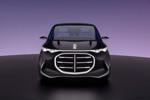You have to go back a long way to understand why we have some names on cars. Looking at the old British car industry, many cars were named after roads, such as the Austin A30, A55 and A60. Then manufacturers moved on to naming them after British places, such as the Morris Oxford, Austin Cambridge, Ford Anglia and Austin Somerset.
The examples are endless and readers who can remember them will be making a mental list. Ford then moved on to more exotic climes. Remember the Ford Capri, the Cortina and the car named after Spain's snow-covered mountains, the Sierra? And, of course, the Granada also had a Spanish flavour.
On the other hand the Spanish company SEAT named its cars after local towns and it still does - Marbella, Ibiza, Malaga, Toledo and Leon. They never used road names like the British - perhaps an 'N340 Coast Road' would never have sold.
The German manufacturers have always been clinical and precise with badging policies, with the exception of Volkswagen.
Mercedes has used 'class' such as E, A, S and C-class derivatives. BMW has its 'series,' the 3, 5, 7and so on. Audi now has the methodical A3, A4, A6, a change from the previous 80, 90 and 100. Volkswagen never really had one policy across the board but all the same it has worked extremely well, whether the cars are named after sports, winds, insects or mints.
The Japanese started out by using words that we Europeans understood, such as the Datsun Cherry, Sunny and Laurel.
Latterly they have reverted to their native tongue but some names can get lost in the translation. There is an old wives' tale about how the Mitsubishi Starion came to have its name.
Apparently the firm tried to have a horse name, being the Colt Car Company, but there was something of a breakdown in communication between the Japanese and Americans. The variance in pronunciation meant the difference between Stallion and Starion.
As the fleet market developed new styles of badging came in. The glamorous names such as Luxe, De-Luxe, Grand Luxe, Grand Tourismo and Super De-Luxe all went down market to become the more mundane L, DL, GL, GT and SDL. You could not have reps getting above their station - car park snobbery was taking hold.
Toyota is moving away from the mundane and old-fashioned versions such as S, GS and CDX to more revolutionary badging in keeping with 2002 and beyond. You have to wonder whether others will follow suit and whether innovation will take over from tradition.
Looking ahead, Skoda has named its forthcoming upper- medium vehicle the Superb, or Super B as it is now being referred to in the industry. It is a quality car with a top spec so it may be apt, but it could be difficult to revive the name of a large 1934 model Skoda with great effect. Next year will also see the launch of the Renault Avantime, a name which means 'before time' in Franglais. And looking at this vehicle, 'before its time' it certainly is.
- FNN allows you to search for REAL prices reached by REAL vehicles sold at the country's leading car auctions. To start your search click here.
















Login to comment
Comments
No comments have been made yet.